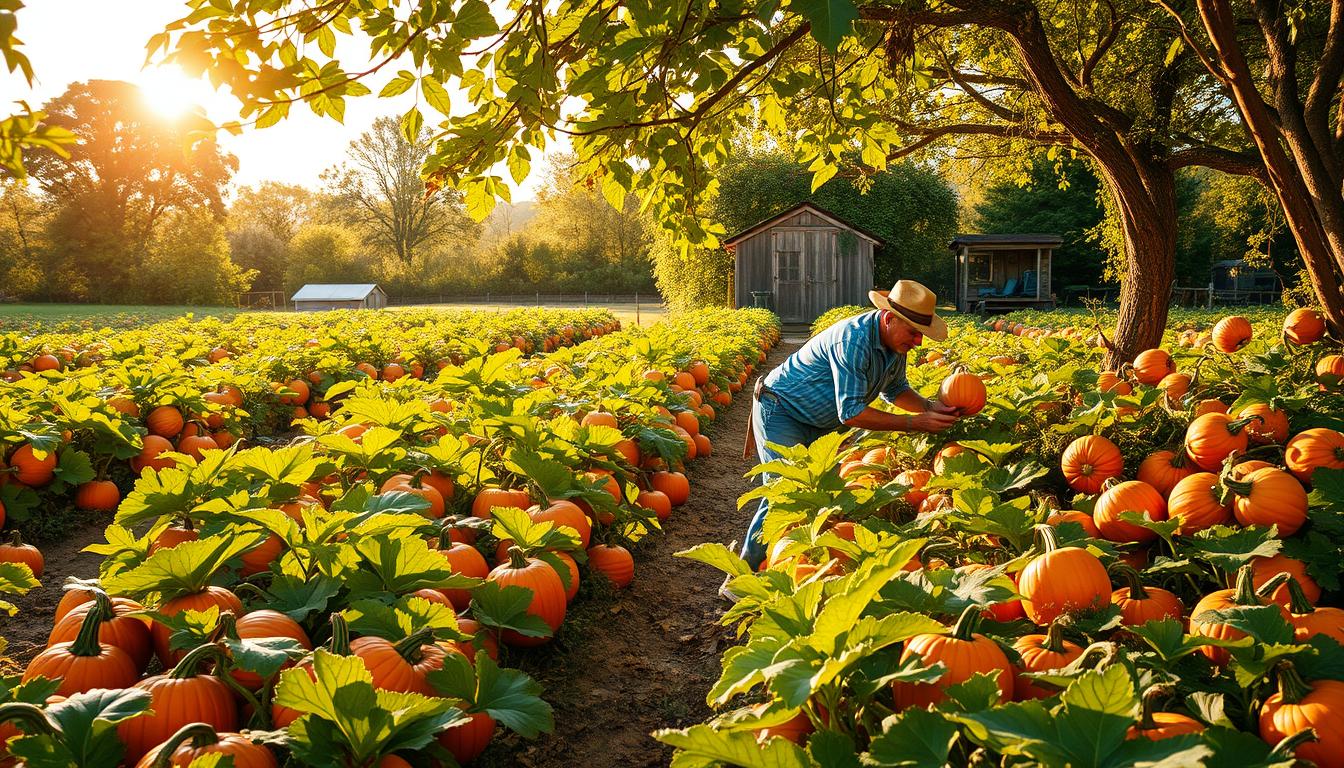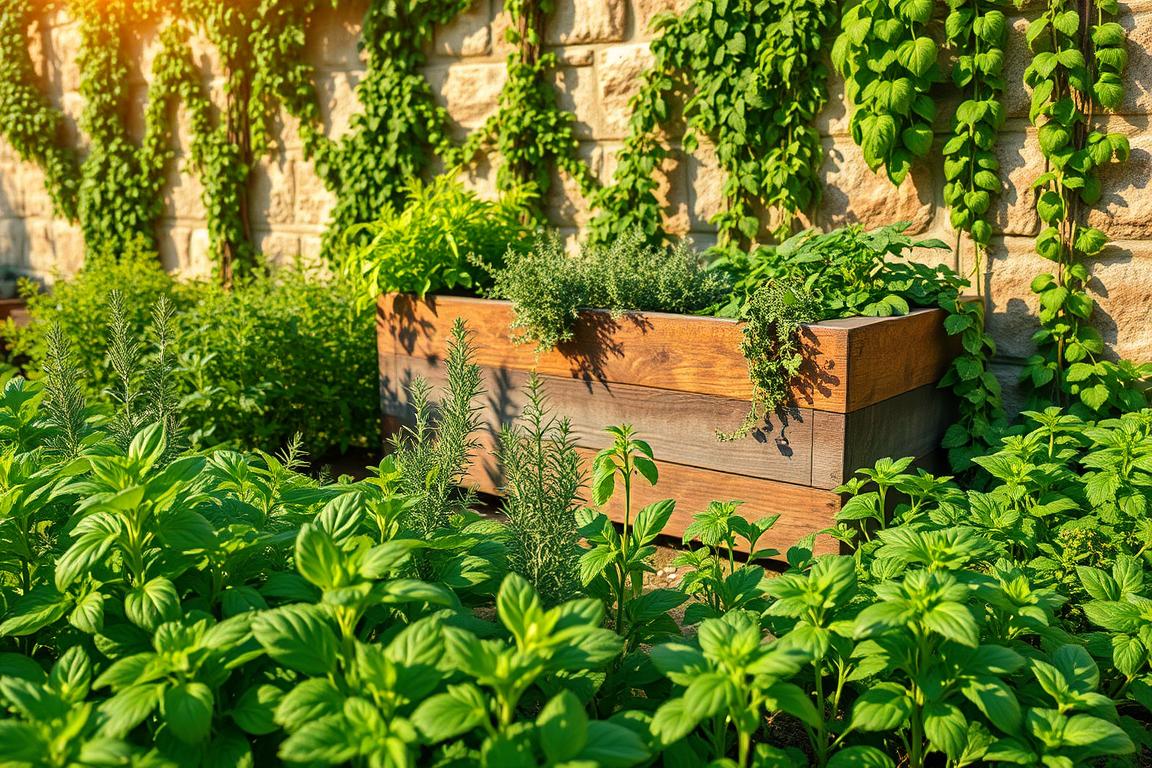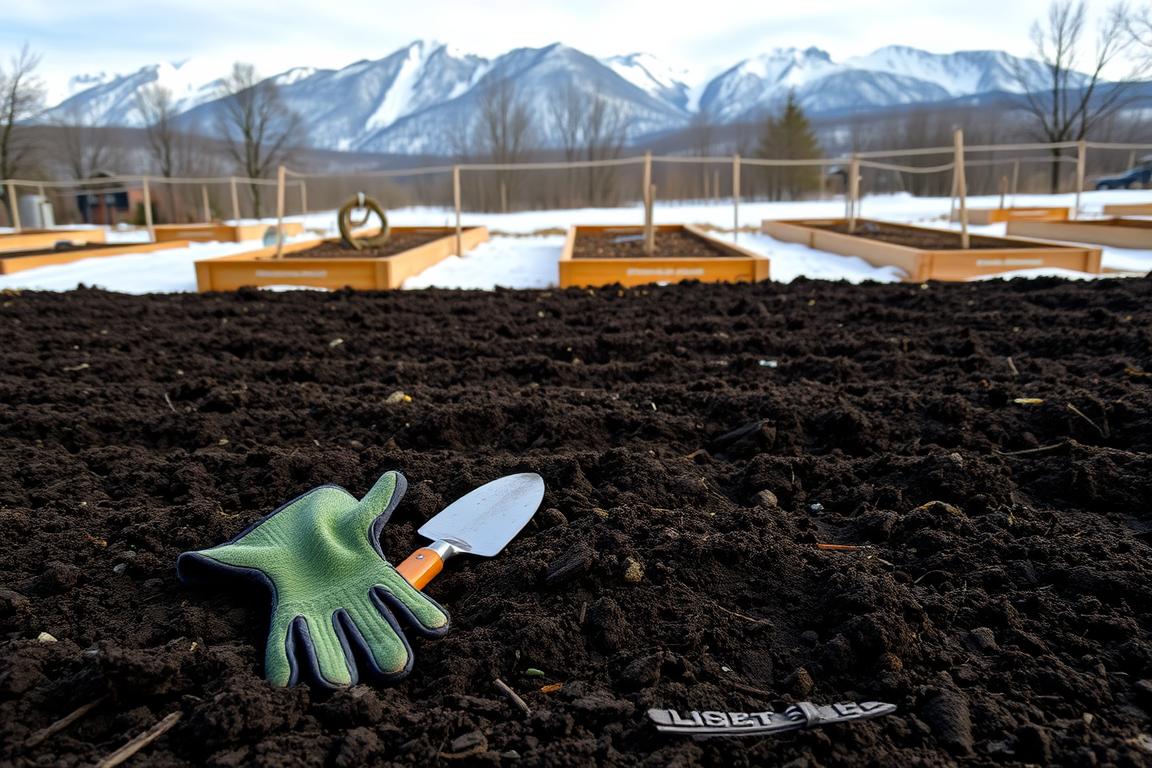A healthy soil ecosystem is the foundation of a thriving garden. Soil is alive, filled with organisms that work together. They help plants grow and keep the garden healthy.
Improving garden soil naturally makes it better for plants. By using organic gardening tips and soil amendments for garden, you can make your garden more sustainable and productive.
Key Takeaways
- Healthy soil is a living ecosystem that supports plant growth.
- Natural soil improvement methods enhance fertility and biodiversity.
- Using organic gardening tips can lead to a more sustainable garden.
- Soil amendments can improve soil structure and overall health.
- DIY soil fertility techniques are effective and easy to implement.
The Importance of Healthy Soil in Your Garden
Healthy soil is key to a thriving garden. It gives plants the nutrients, air, and water they need. A well-kept soil ecosystem is vital for sustainable gardening practices and garden productivity.
Soil health depends on its structure, nutrient content, and biodiversity.
What Makes Soil "Healthy"
Healthy soil supports plant growth, holds moisture, and has many microorganisms. It’s full of organic matter and has the right pH for plants to absorb nutrients well. Enhancing soil health means keeping a balance of air, water, and nutrients.
How Soil Health Affects Plant Growth
Soil health affects how well plants grow. Healthy soil lets plants get air, water, and nutrients easily. This helps roots grow strong and plants stay healthy. Using eco-friendly soil improvement methods helps create a soil ecosystem that supports plant growth.
By using natural soil conditioning methods, gardeners can make soil healthier. This leads to stronger and more productive plants.
Understanding Your Soil: The Foundation of Garden Success
The key to a thriving garden lies beneath our feet, in the soil that nurtures our plants. Knowing your soil is key for enhancing garden soil health and success in gardening.
Different Soil Types and Their Characteristics
The texture of your soil comes from the size of its mineral particles. Soils are grouped into types based on their makeup.
Clay, Sandy, Silt, and Loam Soils
Clay soils are dense and hold moisture well. Sandy soils are loose and drain fast. Silt soils are fertile and smooth. Loam soils, a mix of clay, silt, and sand, are best for gardening because they balance well.
Regional Soil Variations in the United States
Soil types change a lot across the United States. For example, the east has clay-rich soils, and the west has sandy soils. Knowing these differences is crucial for sustainable soil management.
Signs of Healthy vs. Unhealthy Soil
Healthy soil is full of life and has a good structure. It smells earthy, has earthworms, and feels crumbly. Unhealthy soil is compacted, lacks organic matter, or drains poorly. Using eco-friendly soil amendments can improve soil health.
By knowing your soil type and its traits, you can use the right soil conditioning tips. This will help improve its health and structure, leading to a better garden.
Testing and Analyzing Your Garden Soil
Testing your garden soil is the first step to a healthy garden. It helps check if your soil is healthy and if it needs any changes.
DIY Soil Testing Methods
For those who like to get their hands dirty, there are DIY soil tests. They give you insights into your soil’s health and what it’s made of.
The Jar Test for Soil Composition
The jar test is easy to do. Just fill a jar with soil and water, shake it, and wait for it to settle. The layers that form show how much sand, silt, and clay your soil has.
Simple pH and Nutrient Tests
You can test your soil’s pH and nutrients with DIY kits or pH meters. These tools tell you if your soil is too acidic or alkaline and if it’s missing important nutrients.
Earthworm Count and Soil Life Assessment
Looking at earthworms and other soil life can show how healthy your soil is. A healthy soil ecosystem is key for nutrient cycling and soil fertility.
Professional Soil Testing Options
If you want a detailed analysis, send a soil sample to a lab. Labs can give you detailed reports on your soil’s nutrients, pH, and more.
Interpreting Soil Test Results
Understanding your soil test results is crucial. Look for nutrient deficiencies and pH imbalances. Then, adjust your gardening to improve your soil.
Testing and analyzing your garden soil is the first step to a better garden. It leads to a more productive and healthy garden.
Composting: Nature's Perfect Soil Amendment
Compost is known as ‘garden gold’ for gardeners. It’s a game-changer for improving soil quality. It’s made from decomposing organic materials, creating a nutrient-rich soil conditioner for healthy plant growth.
By adding compost to your gardening, you boost soil fertility. You also help the environment with sustainable gardening.
How to Create a Successful Compost Pile
To make a great compost pile, you need to balance a few things. First, knowing the role of green and brown materials is key.
Balancing Green and Brown Materials
Green materials, like kitchen scraps and grass clippings, are high in nitrogen. Brown materials, like dried leaves and straw, are high in carbon. Aim for 2/3 brown materials and 1/3 green materials for best results.
Maintaining Proper Moisture and Aeration
Your compost pile should be moist, like a damp sponge. It also needs good air flow. Turning the pile regularly helps keep oxygen in and speeds up decomposition.
Compost Accelerators and Activators
For faster composting, use accelerators or activators. These can be finished compost, compost tea, or special microorganisms to speed up decomposition.
Compost Tea and Other Compost Applications
Compost tea is a liquid made by steeping compost in water. It’s great for delivering beneficial microbes to plant roots. This boosts soil health and plant vigor. You can also use compost as a soil amendment, mulch, or in potting mixes.
Troubleshooting Common Composting Problems
Common composting issues include bad smells, pests, and slow decomposition. To fix these, keep your pile balanced, moist, and turn it often. For bad smells, add more brown materials or cover the pile.
By following these composting tips and using compost applications wisely, you can greatly improve your garden’s soil. This leads to a more sustainable gardening practice.
“Composting is a simple, effective way to reduce waste while creating a nutrient-rich resource for your garden.”
Mulching Techniques for Soil Health
Mulching is key to better soil health and garden growth. The right mulching methods improve soil structure, keep moisture in, and fight weeds.
Organic Mulch Options and Their Benefits
Organic mulches come from nature and boost soil health. They control soil temperature, improve its structure, and support beneficial organisms.
Straw, Leaves, and Grass Clippings
Straw is light and simple to use, making it a favorite for mulching. Leaves and grass clippings add nutrients and organic matter as they break down.
Wood Chips and Bark
Wood chips and bark last long, perfect for paths and tree areas. They keep weeds down and hold moisture in the soil.
Compost as Mulch
Compost mulch enriches the soil with nutrients. It makes the soil fertile and supports healthy plant growth.
| Mulch Type | Benefits | Best Use |
|---|---|---|
| Straw | Lightweight, easy to apply | Vegetable gardens |
| Leaves | Adds organic matter, nutrients | Around trees, shrubs |
| Grass Clippings | Nitrogen-rich | Lawn areas |
| Wood Chips/Bark | Durable, weed suppression | Pathways, around trees |
| Compost | Rich in nutrients, improves soil fertility | All garden areas |
Proper Mulching Practices
To get the most from mulching, apply it correctly. Use a thin layer (2-3 inches) to avoid harming plants. Keep it a few inches from stems to prevent rot.
Living Mulches and Ground Covers
Living mulches like clover or creeping thyme offer extra benefits. They fix nitrogen and attract good insects. They also protect the soil and increase biodiversity.
How to Improve Your Garden Soil Naturally with Cover Crops
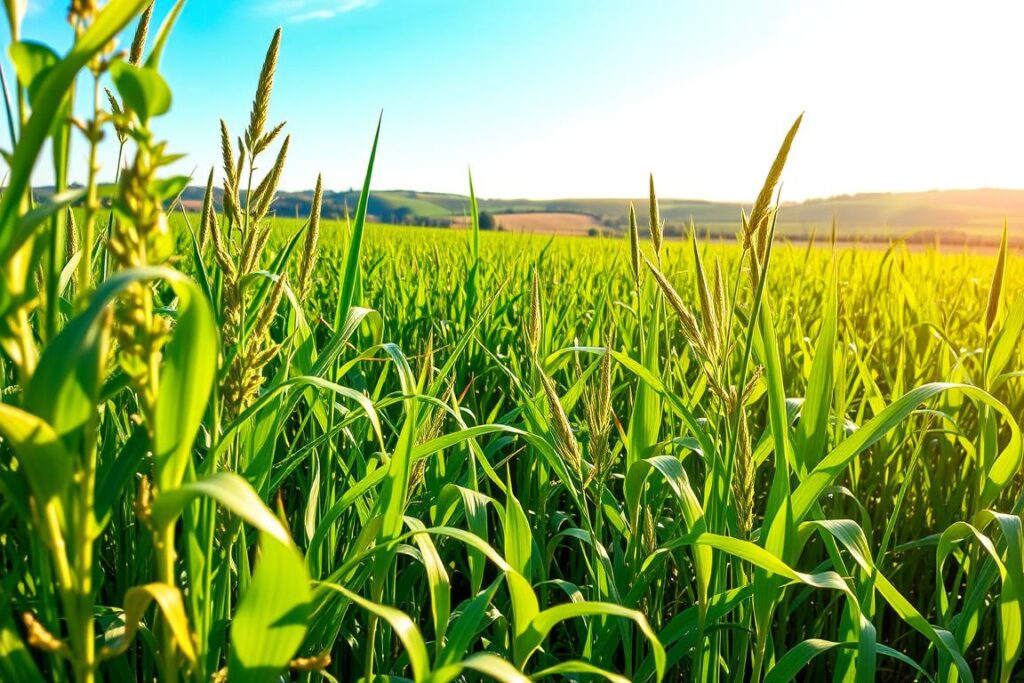
Cover crops are a great way to make your garden soil better. They help improve soil structure, add nutrients, and boost biodiversity.
Selecting the Right Cover Crops for Your Garden
Picking the right cover crops is key to better soil. Each type has its own role, like fixing nitrogen or improving soil texture.
Nitrogen-Fixing Legumes
Legumes like clover and beans are great for adding nitrogen. This is essential for plants to grow well.
Deep-Rooted Crops for Soil Structure
Crops like radishes and daikon break up hard soil. This makes the soil better for water and air to get in.
Winter Cover Crops
Winter crops like rye and winter wheat keep the soil safe when it’s not growing. They stop erosion and add organic matter.
Planting and Managing Cover Crops
Planting and caring for cover crops is important. Choose the right time to plant and mix them into the soil when they’re ready.
Incorporating Cover Crops into the Soil
Adding cover crops to the soil at the right time is crucial. It adds nutrients and organic matter, making the soil more fertile.
| Cover Crop Type | Benefits | Examples |
|---|---|---|
| Nitrogen-Fixing | Increases soil nitrogen | Clover, Beans |
| Deep-Rooted | Improves soil structure | Radishes, Daikon |
| Winter Cover | Prevents erosion, adds organic matter | Rye, Winter Wheat |
Natural Amendments for Specific Soil Issues
Dealing with clay, sand, or nutrient deficiencies? There are natural ways to improve your soil. Each soil type has its own challenges. Understanding these is key to a thriving garden.
Improving Clay Soil Naturally
Clay soil can be dense and hard to drain. Adding compost can change this. It breaks down clay, improving aeration and water flow. Compost also adds nutrients and makes soil more porous.
Enhancing Sandy Soil Structure
Sandy soils drain too fast and lack nutrients. Adding organic matter like compost or manure helps. It keeps moisture and nutrients in. Mulching also helps by reducing erosion and improving soil health.
Balancing Soil pH Without Chemicals
Soil pH affects how plants get nutrients and how microbes work. To balance pH naturally, use specific amendments.
Raising pH Naturally
For acidic soils, dolomitic limestone is a good choice. It raises pH and adds calcium and magnesium, vital for plants.
Lowering pH Naturally
For alkaline soils, elemental sulfur or peat moss can lower pH. These natural options create an acidic environment plants need.
Addressing Nutrient Deficiencies Organically
Nutrient deficiencies can be fixed with organic fertilizers and conditioners. A soil test shows what nutrients are missing. Use targeted amendments like fish bone meal for phosphorus or kelp meal for micronutrients.
| Soil Issue | Natural Amendment | Benefit |
|---|---|---|
| Clay Soil | Compost | Improves structure and drainage |
| Sandy Soil | Organic matter (compost or manure) | Retains moisture and nutrients |
| Low pH | Dolomitic limestone | Raises pH, adds calcium and magnesium |
| High pH | Elemental sulfur or peat moss | Lowers pH |
| Nutrient deficiency | Organic fertilizers (e.g., fish bone meal, kelp meal) | Provides specific nutrients |
Sustainable Practices for Long-Term Soil Health
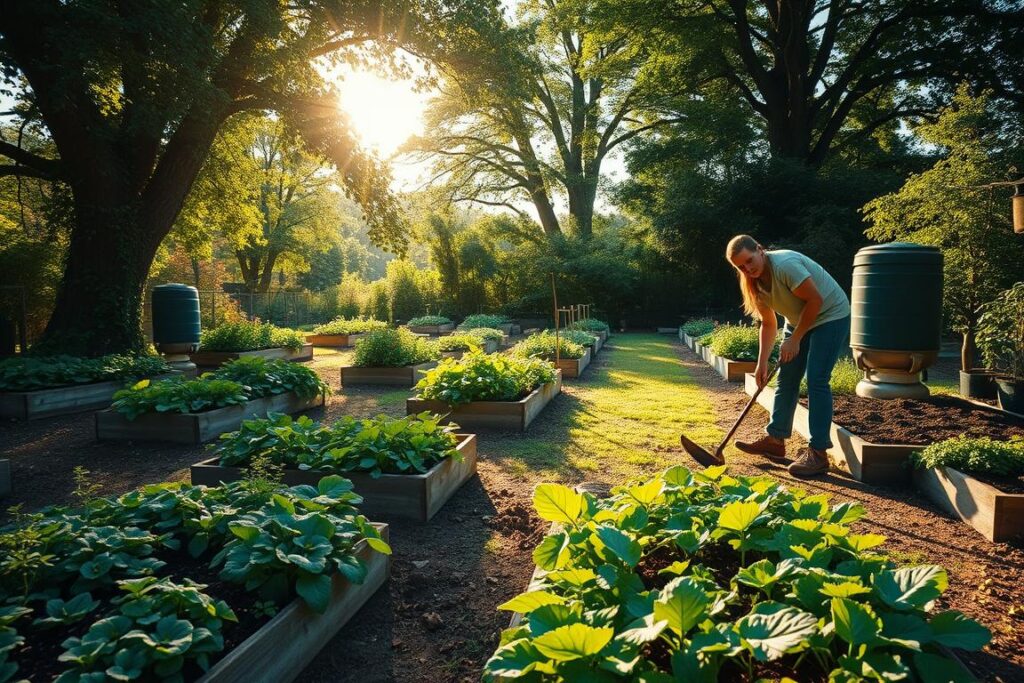
Good soil health is key to a successful garden. By using practices that improve soil, gardeners can keep their gardens thriving for years.
Crop Rotation and Its Benefits
Crop rotation is a basic part of gardening sustainably. It means changing what you grow in a spot to keep the soil rich and prevent pests. Crop rotation helps avoid disease and keeps nutrients balanced, making plants healthier and soil better.
- Improves soil fertility
- Reduces pest and disease pressure
- Enhances crop diversity
No-Till and Minimal Tillage Methods
No-till and minimal tillage help keep soil healthy. These methods avoid tilling, which can harm the soil. By doing less tillage, gardeners help keep soil biota alive and improve water absorption, making the soil stronger.
| Method | Benefits |
|---|---|
| No-Till | Reduces soil erosion, improves water retention |
| Minimal Tillage | Preserves soil structure, promotes soil biota |
Building Soil Biodiversity
Soil biodiversity is vital for a healthy garden. It means creating a home for many soil creatures. Helping beneficial microbes and making a home for earthworms and other creatures is important for biodiversity.
Encouraging Beneficial Microorganisms
Good microbes are essential for breaking down organic matter and fighting diseases. Adding compost and using cover crops helps these microbes thrive.
Creating Habitat for Earthworms and Soil Fauna
Earthworms and other creatures are important for soil health. They help break down organic matter and improve soil. Adding organic matter and reducing tillage makes a good home for them.
Conclusion: Nurturing Soil for a Thriving Garden
Nurturing your garden’s soil is key to a thriving garden. By composting, mulching, and using cover crops, you can boost soil health. Healthy soil is full of good microbes, has the right structure, and keeps nutrients, all vital for plants.
Using sustainable gardening practices makes your soil better and helps the environment. Rotating crops, reducing tillage, and using natural amendments keep soil healthy long-term. This makes your garden strong against pests and diseases.
Follow these tips to have a garden with healthy, productive soil. Caring for your soil is a long-term effort that needs patience and dedication to sustainable gardening. As you care for your garden, remember that your soil’s health directly affects your plants’ success.
FAQ
What are the benefits of improving garden soil naturally?
Natural soil improvement boosts soil health and plant growth. It leads to better crop yields and a greener gardening way.
How do I know if my soil is healthy?
Healthy soil has good structure and nutrients. It smells earthy and holds moisture well. Look for earthworms and a balanced feel.
What is the best way to test my garden soil?
Test your soil with DIY tools like the jar test or pH strips. Or, send a sample to a lab for detailed analysis.
How can I improve the structure of clay or sandy soil?
Use compost or manure to fix clay or sandy soil. It improves drainage in clay and moisture in sand.
What is compost tea and how is it used?
Compost tea is a liquid made from steeping compost in water. It’s used to boost soil health and plant growth.
How can I balance my soil pH without using chemicals?
Use compost or manure to adjust pH naturally. Dolomitic limestone raises pH, while sulfur or peat moss lowers it.
What are the benefits of using cover crops in my garden?
Cover crops enrich soil, reduce erosion, and attract beneficial insects. They also control weeds and pests.
How can I maintain long-term soil health?
Use sustainable methods like crop rotation and minimal tillage. Add organic amendments to keep soil healthy and diverse.
What is the role of microorganisms in maintaining healthy soil?
Microorganisms like bacteria and fungi are key to soil health. They break down organic matter, fix nitrogen, and fight diseases.
How can I improve soil fertility organically?
Add compost, manure, or fish bone meal to enrich soil. These natural amendments feed plants and support beneficial microbes.
What are some eco-friendly soil enrichment techniques?
Use organic matter, cover crops, and compost tea to enrich soil. These methods boost soil health and biodiversity.




